Comic Book Confidential: Simply Spectacular
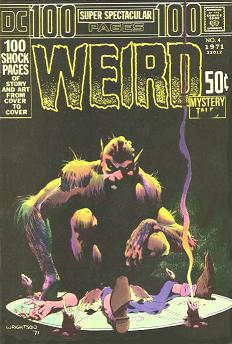
Even though it was marked DC-4, this is the cover for the first 100 Page Super Spectacular.
Being a comic book kid in the early 1970’s was a glorious thing. We didn’t realize it at the time, but DC Comics was giving us an education in the disguise of entertainment. Many of their core comic titles had been expanded to include additional pages (at an increased cost of course) and most of these pages were being filled with reprints of stories from decades earlier. This tactic worked so well that DC decided to dedicate an entire series to these reusable relics and the DC 100 Page Super Spectacular was born!
DC took a rather radical departure from the standard comic books of the day, which cost a mere twelve cents, and created a 100 page behemoth devoid of commercial advertisements and retailing for a whopping fifty cents. This may seem like a laughable bargain today but since it was over four times the cost of a regular book this could present some serious challenges to allowances back in the day. Assistant Editor E. Nelson Bridwell, a man known for his encyclopedia like knowledge of comic books and who had recently tackled the job of publishing hardcover treasuries for Superman, Batman, and the newly DC licensed Captain Marvel, readily accepted the dream job of editing an ongoing series comprised entirely of classic tales.
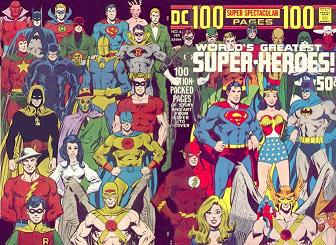
The impressive cover for DC-6 which really kicked the series into high gear!
For reasons lost to time, the DC 100 Page Super Spectacular series began with issue number 4, a book dedicated to Weird Mystery stories and sporting impressive cover artwork by Bernie Wrightson. While this may have been a rather strange debut, issue number 5 was devoted to Love Stories and, as might be anticipated, sold poorly. It can only be assumed that these first two faltering steps were taken to test the waters and buy some time while issue number 6, titled The World’s Greatest Superheroes, was being assembled. This issue really did live up to the Spectacular name, starting with an outstanding wrap around cover designed by Neil Adams and featuring almost every hero from the combined might of the Justice League and Justice Society plus a couple of extras featured in the book. Inside was the very first reprinting of the landmark initial cross over between the Silver Age Justice League of America and the Golden Age Justice Society of American plus a generous accompaniment of excellent Golden Age superhero tales. Also included was the very first who’s who compendium of characters owned by DC Comics which Bridwell painstakingly compiled. This gave younger readers their very first glimpse at a number of classic heroes, many of whose adventures they would be reading in the near future in this title.
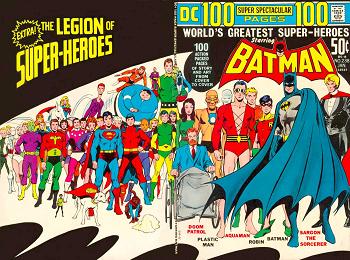
DC-8 was not only the first Super Spectacular I ever read but also one of my very first comic books as a kid. What a great start.
The response to issue number 6 was overwhelming and it quickly became a collector’s item, something unusual for a comic book comprised entirely of reprints. With the exception of a couple of deviations into war stories and one attempt to tout their recently acquired copyright to the comic book characterization of Tarzan, DC wisely stuck to superhero themes for the remainder of the original 100 Page Super Spectacular’s nineteen issue run through number 22. The headlines to these books were given over to popular heroes of the day like Superman, Batman, Flash, Superboy, and even the Justice League of America but the true gold, or Golden Age, was in the supporting stories. Regardless of who the supposed star of an issue was stated to be, every 100 Page Super Spectacular was crammed full of Golden Ages stories featuring an impressive roster of characters. Many of these characters, like The Spectre, Dr. Fate, Blackhawk, and Hourman were already familiar to readers through their Silver Age revivals. Others like Kid Eternity, Doll Man, Sargon the Sorcerer, Air Wave, and Super Chief were all brand new to the current generation of comic book fans. With a massive 100 pages to fill, the Silver Age, which was already over a decade old by this point, was not ignored either. DC dusted off early adventures of the Legion of Superheroes, Atom, Hawkman, the Doom Patrol, and many others to pack these issues to the very brim with great reading.
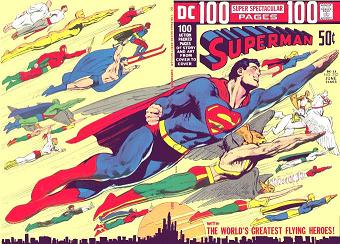
Another impressive wrap-around cover for DC-13 which featured the world’s greatest flying heroes.
The history of the 100 Page Super Spectaculars started off strangely with its debut with issue 4 and continued to become increasingly more convoluted. The first few issues of the book were restricted to its own series numbering just like any other comic book. Beginning with issue DC-7, which was also listed as Superman #245, some of the Super Spectaculars also counted as issues of the featured hero’s regular title. Comic book collectors have spent years trying to figure out whether to file these books under their title or the other series they fit into but one thing is certain, DC figured out a very easy way to cut down on their publishing costs when they needed to! Apparently this proved to be such a smart move that beginning with what would have been 100 Page Super Spectacular DC-23, an issue featuring the newly licensed Captain Marvel – better known as Shazam now thanks to legal problems, all future editions would be published only as parts of a regular comic book series.
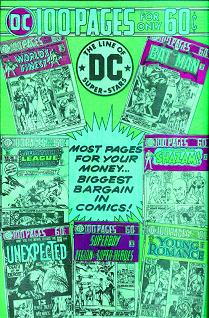
A DC house ad from 1974 showing the newly revised format where 100 pages now cost .60 cents and included advertisements.
The new numbering scheme wasn’t the only revision the Spectaculars went through in late 1973. The price was increased by 20% to .60 cents per book and the page count, while still numbering 100 total, now included advertisements which significantly reduced the entertainment content. In a subtle truth in advertising move, DC modified the logo of these books so that they still promised 100 Pages but the words Super Spectacular were conspicuously missing. Even with these unwelcome changes the content continued to be strong. The only noticeable difference was that lead features were now new stories and the reprints tended to be more closely themed to the title and more often sourced from older issues of the same book.
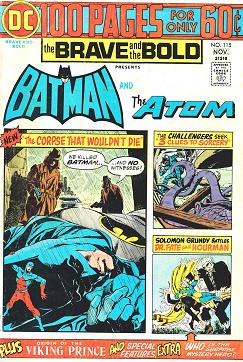
One of the final 100 pages issues of Brave and the Bold which was also the end of the Super Spectacular series.
DC also branched out with the revised series and included several of their horror titles like Tales of the Unexpected and House of Mystery in the mix. They also insisted on revisiting the love stories as well with multiple issues of Young Romance in a futile effort to bring young girls into the hobby of comic book reading. Aside from a few additional Tarzan volumes, the remainder of the titles were all superhero ones and managed, for the most part, to uphold the high standards set by the previous issues. Unfortunately DC seemed to never be quite sure what they wanted to do with these editions. Some titles had consistent runs while others popped in and out with no rhyme or reason. As the series was coming to an end in early 1975, DC pulled out a previously unused title, the Batman team up book Brave and the Bold, and used it exclusively for the final half dozen issues in this format all the way through to 1976.
Many other DC compilation titles like DC Special continued on after the 100 Page Super Spectaculars finished their five year run and many others such as DC Superstars and Four Star Spectacular were still on the horizon. None of them ever came close to offering the value and story selection that this series did though. Many of the heroes featured in the back up stories of the Spectaculars would not be heard from again for close to a decade when DC decided to do some major house cleaning in 1985 with the Crisis on Infinite Earths. To this day, the 100 Page Super Spectaculars are still the most economical way to read many of their stories and even with the inflated value they have achieved as collectibles they are still well worth the price.
